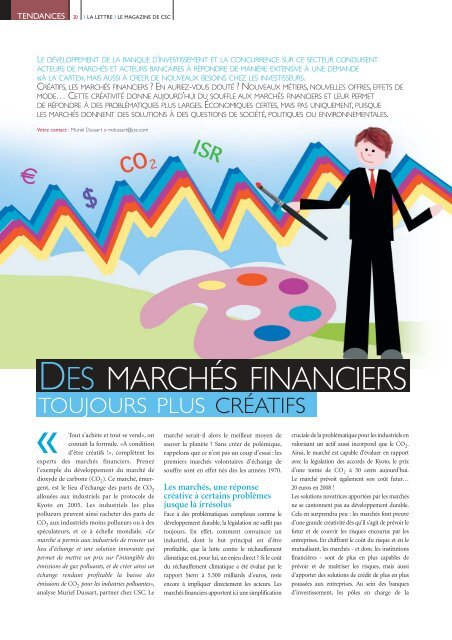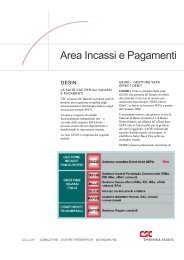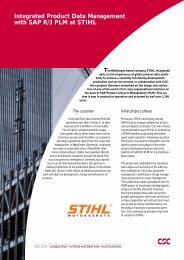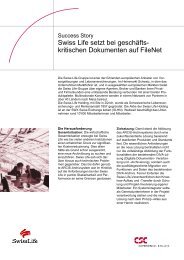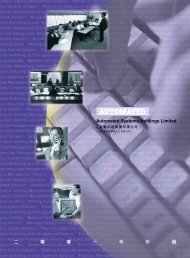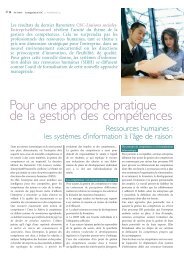TENDANCES 20 ( LA LETTRE ) LE MAGAZINE DE <strong>CSC</strong>LE DÉVELOPPEMENT DE LA BANQUE D’INVESTISSEMENT ET LA CONCURRENCE SUR CE SECTEUR CONDUISENTACTEURS DE MARCHÉS ET ACTEURS BANCAIRES À RÉPONDRE DE MANIÈRE EXTENSIVE À UNE DEMANDE«À LACARTE», MAIS AUSSI À CRÉER DE NOUVEAUX BESOINS CHEZ LES INVESTISSEURS.CRÉATIFS, LES MARCHÉS FINANCIERS ? EN AURIEZ-VOUS DOUTÉ ? NOUVEAUX MÉTIERS, NOUVELLES OFFRES, EFFETS DEMODE… CETTE CRÉATIVITÉ DONNE AUJOURD’HUI DU SOUFFLE AUX MARCHÉS FINANCIERS ET LEUR PERMETDE RÉPONDRE À DES PROBLÉMATIQUES PLUS LARGES.ÉCONOMIQUES CERTES, MAIS PAS UNIQUEMENT, PUISQUELES MARCHÉS DONNENT DES SOLUTIONS À DES QUESTIONS DE SOCIÉTÉ, POLITIQUES OU ENVIRONNEMENTALES.Votre contact : Muriel Dussart > mdussart@csc.comDES MARCHÉS FINANCIERSTOUJOURS PLUS CRÉATIFS«Tout s’achète et tout se vend», onconnaît la formu<strong>le</strong>. «À conditiond’être créatifs !», complètent <strong>le</strong>sexperts <strong>de</strong>s marchés financiers. Prenezl’exemp<strong>le</strong> du développement du marché <strong>de</strong>dioxy<strong>de</strong> <strong>de</strong> carbone (CO 2 ). Ce marché, émergent,est <strong>le</strong> lieu d’échange <strong>de</strong>s parts <strong>de</strong> CO 2allouées aux industriels par <strong>le</strong> protoco<strong>le</strong> <strong>de</strong>Kyoto en 2005. Les industriels <strong>le</strong>s pluspollueurs peuvent ainsi racheter <strong>de</strong>s parts <strong>de</strong>CO 2 aux industriels moins pollueurs ou à <strong>de</strong>sspéculateurs, et ce à échel<strong>le</strong> mondia<strong>le</strong>. «Lemarché a permis aux industriels <strong>de</strong> trouver unlieu d’échange et une solution innovante quipermet <strong>de</strong> mettre un prix sur l’intangib<strong>le</strong> <strong>de</strong>sémissions <strong>de</strong> gaz polluants, et <strong>de</strong> créer ainsi unéchange rendant profitab<strong>le</strong> la baisse <strong>de</strong>sémissions <strong>de</strong> CO 2 pour <strong>le</strong>s industries polluantes»,analyse Muriel Dussart, partner chez <strong>CSC</strong>. Lemarché serait-il alors <strong>le</strong> meil<strong>le</strong>ur moyen <strong>de</strong>sauver la planète ? Sans créer <strong>de</strong> polémique,rappelons que ce n’est pas un coup d’essai : <strong>le</strong>spremiers marchés volontaires d’échange <strong>de</strong>souffre sont en effet nés dès <strong>le</strong>s années 1970.Les marchés, une réponsecréative à certains problèmesjusque là irrésolusFace à <strong>de</strong>s problématiques comp<strong>le</strong>xes comme <strong>le</strong>développement durab<strong>le</strong>, la législation ne suffit pastoujours. En effet, comment convaincre unindustriel, dont <strong>le</strong> but principal est d’êtreprofitab<strong>le</strong>, que la lutte contre <strong>le</strong> réchauffementclimatique est, pour lui, un enjeu direct ? Si <strong>le</strong> coûtdu réchauffement climatique a été évalué par <strong>le</strong>rapport Stern à 5.500 milliards d’euros, resteencore à impliquer directement <strong>le</strong>s acteurs. Lesmarchés financiers apportent ici une simplificationcrucia<strong>le</strong> <strong>de</strong> la problématique pour <strong>le</strong>s industriels envalorisant un actif aussi incorporel que <strong>le</strong> CO 2 .Ainsi, <strong>le</strong> marché est capab<strong>le</strong> d’évaluer en rapportavec la législation <strong>de</strong>s accords <strong>de</strong> Kyoto, <strong>le</strong> prixd’une tonne <strong>de</strong> CO 2 à 50 cents aujourd’hui.Le marché prévoit éga<strong>le</strong>ment son coût futur…20 euros en 2008 !Les solutions novatrices apportées par <strong>le</strong>s marchésne se cantonnent pas au développement durab<strong>le</strong>.Cela en surprendra peu : <strong>le</strong>s marchés font preuved’une gran<strong>de</strong> créativité dès qu’il s’agit <strong>de</strong> prévoir <strong>le</strong>futur et <strong>de</strong> couvrir <strong>le</strong>s risques encourus par <strong>le</strong>sentreprises. En chiffrant <strong>le</strong> coût du risque et en <strong>le</strong>mutualisant, <strong>le</strong>s marchés - et donc <strong>le</strong>s institutionsfinancières - sont <strong>de</strong> plus en plus capab<strong>le</strong>s <strong>de</strong>prévoir et <strong>de</strong> maîtriser <strong>le</strong>s risques, mais aussid’apporter <strong>de</strong>s solutions <strong>de</strong> crédit <strong>de</strong> plus en pluspoussées aux entreprises. Au sein <strong>de</strong>s banquesd’investissement, <strong>le</strong>s pô<strong>le</strong>s en charge <strong>de</strong> la
( LA LETTRE ) LE MAGAZINE DE <strong>CSC</strong> 21COMME POUR LA MODE,LA FINANCE EST L’OBJETDE TENDANCES…ET CELLES-CI DURENTDE MOINS EN MOINSLONGTEMPScontinuité du service (Business Continuity Units)peuvent aujourd’hui établir <strong>le</strong> coût <strong>de</strong> risques aussifins que ceux que représentent la grippe aviaire ouune attaque terroriste.Des marchés plus régulés permettent aujourd’huid’éviter, dans une plus gran<strong>de</strong> mesure, ce que <strong>le</strong>sfinanciers nomment «risque systémique» (laparalysie <strong>de</strong> l'ensemb<strong>le</strong> du système financier,par <strong>le</strong> biais d’engagements croisés et d’uneffet «bou<strong>le</strong> <strong>de</strong> neige»). Alors que <strong>le</strong>s pertes dufonds spéculatif (hedge fund) Long-TermCapital Management avaient menacé l’économiemondia<strong>le</strong> en 1998, la faillite du géantAmaranth Advisors, l’an <strong>de</strong>rnier, a pu êtreabsorbée par <strong>le</strong>s marchés. Plus institutionnalisés,<strong>le</strong>s marchés financiers sont plus sûrs, et sedémocratisent avec l’apparition du capitalismepatrimonial. Par <strong>le</strong> biais <strong>de</strong> fonds <strong>de</strong> pensionsou <strong>de</strong> participation salaria<strong>le</strong>, la finance <strong>de</strong>vientaccessib<strong>le</strong> à un plus grand nombre. Lemarché est donc un lieu social où unepopulation grandissante déci<strong>de</strong> ensemb<strong>le</strong> <strong>de</strong>sinvestissements futurs.Un secteur dynamiséLes marges importantes <strong>de</strong>s opérations <strong>de</strong>marchés attirent <strong>le</strong>s banques mais engendrentéga<strong>le</strong>ment la multiplication <strong>de</strong> structurescomme <strong>le</strong>s fonds spéculatifs ou <strong>le</strong>s organismes<strong>de</strong> placement col<strong>le</strong>ctif en va<strong>le</strong>urs mobilières(OPCVM). Ainsi <strong>le</strong> nombre <strong>de</strong> fonds spéculatifsest passé <strong>de</strong> 2.000 en 1990 à 9.000 en 2004.<strong>La</strong> concurrence accrue sur ce secteur rend lacourse au profit plus ardue, mais dynamise <strong>le</strong>secteur et pousse à la créativité. Les banquesd’investissement recrutent <strong>de</strong> plus en plus <strong>de</strong>profils très variés, allant du mathématicien auMBA en finance, et <strong>de</strong> nouveaux métiers sontcrées pour établir <strong>de</strong> nouvel<strong>le</strong>s offres et créer <strong>de</strong>nouveaux besoins.<strong>La</strong> diffusion <strong>de</strong>s produits structurés, produitsfinanciers comp<strong>le</strong>xes issus <strong>de</strong> superpositions et<strong>de</strong> combinaisons <strong>de</strong> produits «vanil<strong>le</strong>s» comme<strong>le</strong>s actions ou <strong>le</strong>s obligations, a institué parexemp<strong>le</strong> <strong>le</strong> métier <strong>de</strong> structureur, en charge dumontage et <strong>de</strong> la conception <strong>de</strong> ces produits.Ces nouveaux produits qui mettent à contributionla créativité et la réactivité au marché dustructureur dégagent en effet une marge plusimportante liée au travail <strong>de</strong> structuration.Autre exemp<strong>le</strong> : celui <strong>de</strong> l’investissementsocia<strong>le</strong>ment responsab<strong>le</strong> (ISR) qui consiste àsé<strong>le</strong>ctionner pour <strong>de</strong>s fonds dédiés parexemp<strong>le</strong>, <strong>le</strong>s titres <strong>de</strong>s entreprises <strong>le</strong>s plusperformantes en termes <strong>de</strong> critères financiersmais aussi <strong>de</strong> critères sociaux, et qui est assurépar <strong>le</strong>s analyste ISR, un autre métier émergent,notamment en France. D’autres investissements«à la carte» sont possib<strong>le</strong>s et entraînent lacréation <strong>de</strong> postes <strong>de</strong> spécialistes afférents. Pourexemp<strong>le</strong>, <strong>le</strong>s analystes <strong>de</strong> fonds islamiquesassurent aux investisseurs la conformité <strong>de</strong> <strong>le</strong>uroffre d’investissement aux principes <strong>de</strong> l’Islamen refusant certains secteurs industriels et enévitant <strong>le</strong>s produits à intérêt direct.Le revers <strong>de</strong> la créativité : uneindustrie changeante et rythméepar <strong>le</strong>s mo<strong>de</strong>s<strong>La</strong> volatilité et la liquidité entraînées parla spéculation <strong>de</strong> masse accroissent <strong>le</strong>s cyc<strong>le</strong>set <strong>le</strong>s mouvements financiers. Le rythmefrénétique <strong>de</strong>s marchés financiers peut mêmerencontrer la comparaison avec celui <strong>de</strong>l’industrie <strong>de</strong> la mo<strong>de</strong>. Comme pour la mo<strong>de</strong>,la finance est l’objet <strong>de</strong> tendances… et cel<strong>le</strong>scidurent <strong>de</strong> moins en moins longtemps.Il existe ainsi <strong>de</strong>s produits phares <strong>de</strong> lafinance, avec par exemp<strong>le</strong>, <strong>le</strong> succès rencontrépour <strong>le</strong>s matières premières (commodities) ou<strong>le</strong>s trackers, <strong>de</strong>s outils financiers dont la va<strong>le</strong>urmonétaire ou <strong>le</strong> taux <strong>de</strong> ren<strong>de</strong>ment estdirectement et tota<strong>le</strong>ment in<strong>de</strong>xé surl'évolution d'une donnée économique oufinancière (taux d'intérêt, indice boursier,résultats d'une branche d'activité d'uneentreprise, etc.)Autre parallè<strong>le</strong> avec la mo<strong>de</strong>, <strong>le</strong>s investisseurset spéculateurs <strong>de</strong> masse n’hésitent plus àsuivre <strong>le</strong>s traces <strong>de</strong>s stars du milieu –<strong>le</strong>s gérants <strong>de</strong> fonds Warren Buffett (BerkshireHathaway) ou Abigail Johnson (Fi<strong>de</strong>lity) – et àrepérer <strong>le</strong>s stratégies <strong>de</strong> ces «créateurs<strong>de</strong> mo<strong>de</strong>» pour faire mieux que la moyenne<strong>de</strong>s performances <strong>de</strong>s marchés.TROIS QUESTIONS À UN FINANCIER CRÉATIFJean-François Cauvet est tra<strong>de</strong>r <strong>de</strong> dioxy<strong>de</strong> <strong>de</strong>carbone (CO 2 ) chez Sagacarbon, filia<strong>le</strong> <strong>de</strong> la Caisse<strong>de</strong>s Dépôts, premier courtier entièrement dédié aumarché <strong>de</strong>s quotas <strong>de</strong> CO 2 . Entretien.Comment résumer <strong>le</strong>s principes du trading <strong>de</strong> CO 2 ?Le trading (négoce) <strong>de</strong> CO 2 est comparab<strong>le</strong> àun trading plus «classique», en termes <strong>de</strong>techniques. Le contexte juridique et institutionneldiffère cependant. On s’appuie sur <strong>de</strong> l’informationpolitique, institutionnel<strong>le</strong>, et environnementa<strong>le</strong>qu’il faut utiliser pour gérer <strong>de</strong>s flux, en plus<strong>de</strong>s traditionnel<strong>le</strong>s informations économiquescomme <strong>le</strong> prix du baril <strong>de</strong> Brent, du gaz ou ducharbon.Quels sont <strong>le</strong>s aspects <strong>le</strong>s plus créatifs <strong>de</strong> votreprofession ?Le marché du CO 2 est un marché jeune, toutjuste sorti <strong>de</strong> sa gestation. Il s’agit éga<strong>le</strong>mentd’un produit qui représente une nouvel<strong>le</strong>contrainte pour <strong>le</strong>s industriels, à savoir laréduction <strong>de</strong>s émissions <strong>de</strong> CO 2 . En tant quetra<strong>de</strong>r <strong>de</strong> CO 2 , je dois m’adapter à un nouveaumarché et participer à son adoption par <strong>le</strong>sindustriels. Comme Albert Einstein <strong>le</strong> soulignait :«Aucun problème ne peut être résolu sanschanger l'état d'esprit qui l'a engendré.»Quel est l’avenir <strong>de</strong> ce marché ?À l’origine, il y a eu certaines erreurs sur <strong>le</strong>marché du CO 2 . À partir <strong>de</strong> 2008, l’attribution<strong>de</strong> quotas d’émission <strong>de</strong> CO 2 sera plus limitée,et <strong>le</strong> marché plus efficace. En parallè<strong>le</strong>, <strong>le</strong>spolitiques et <strong>le</strong>s industriels ont pris conscience,notamment avec <strong>le</strong> rapport Stern, que ne pas sesoucier <strong>de</strong> l’écologie était désastreux pourl’économie. L’avenir du marché du CO 2 est doncprometteur. Ce marché pourrait même <strong>de</strong>venirglobal, en ralliant par <strong>de</strong>s plates-formes régiona<strong>le</strong>scertains pays qui n’ont pas encore ratifié <strong>le</strong>protoco<strong>le</strong> <strong>de</strong> Kyoto.PHOTOGRAPHIE :CAISSE DES DÉPÔTS 2007 /OLIVIER LONDE


